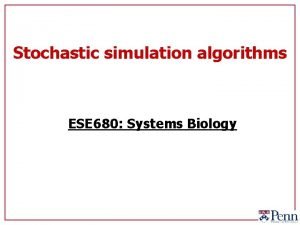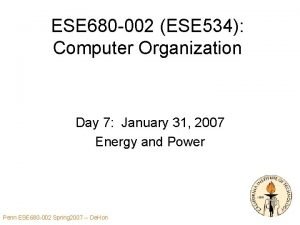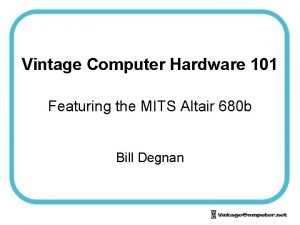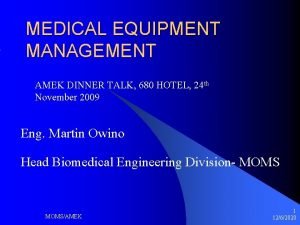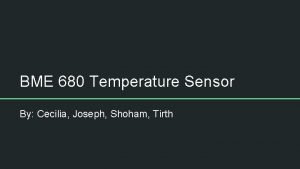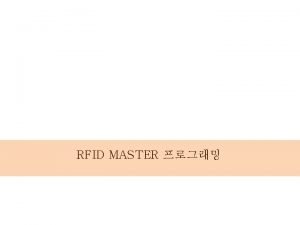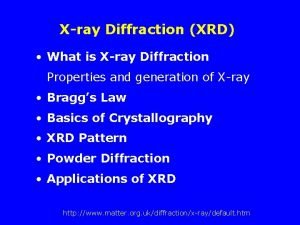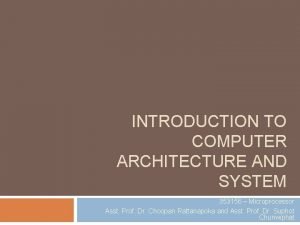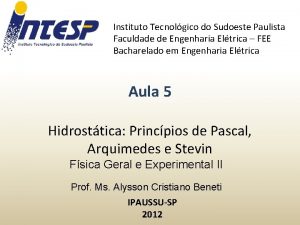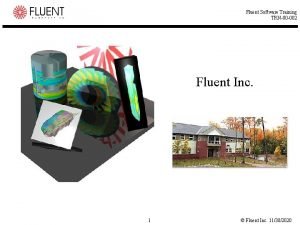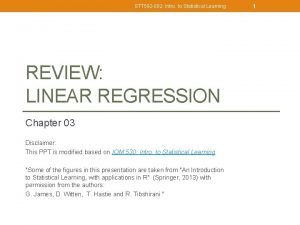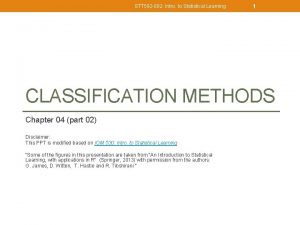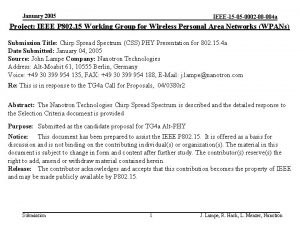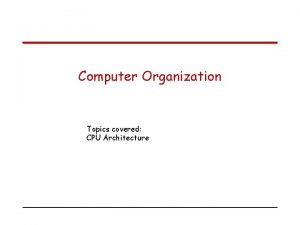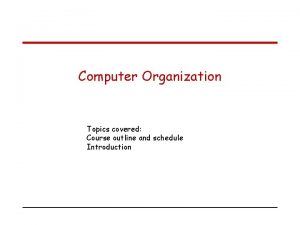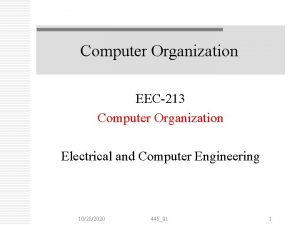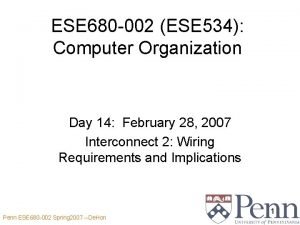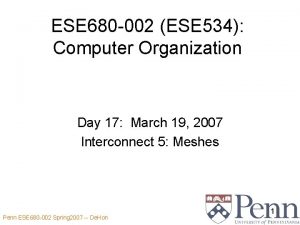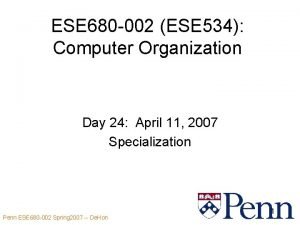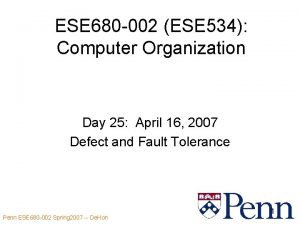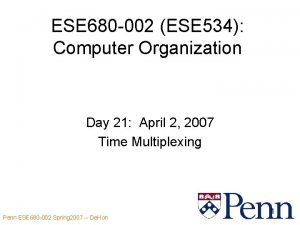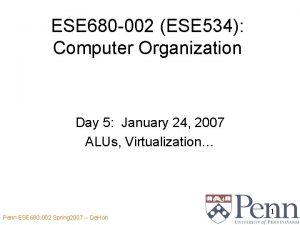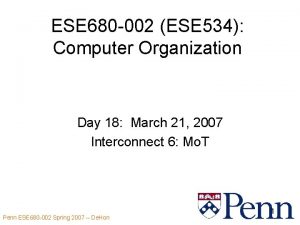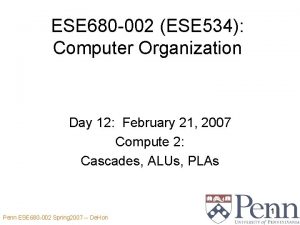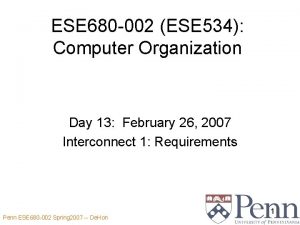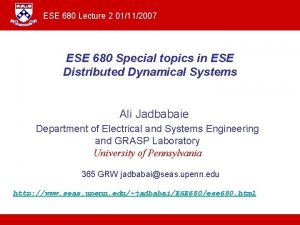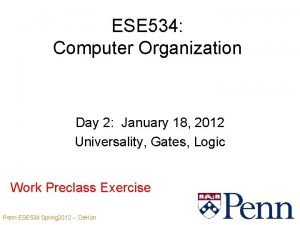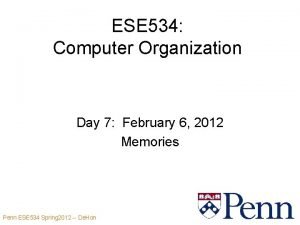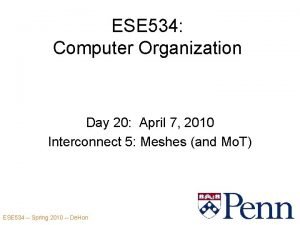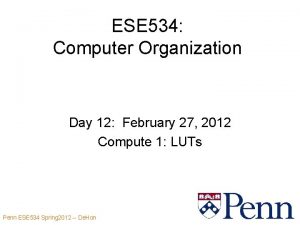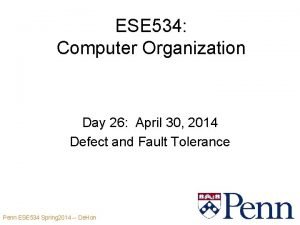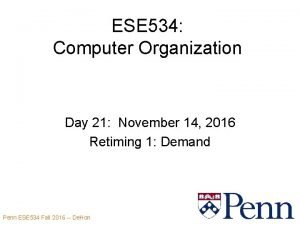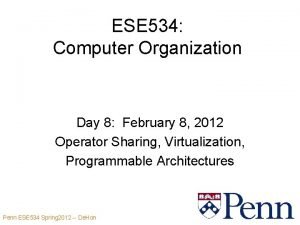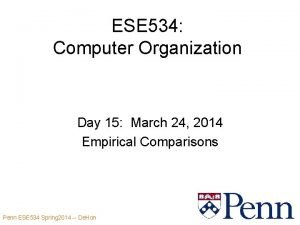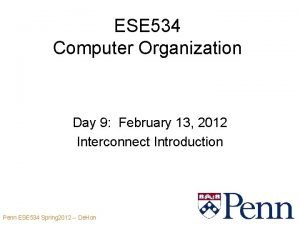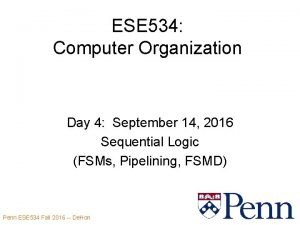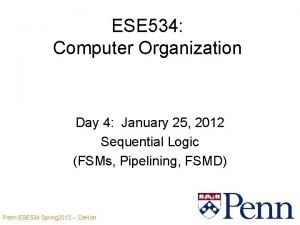ESE 680 002 ESE 534 Computer Organization Day






































































![Big Ideas [MSB Ideas] • Retiming transformations important to – minimize cycles – efficiently Big Ideas [MSB Ideas] • Retiming transformations important to – minimize cycles – efficiently](https://slidetodoc.com/presentation_image_h2/85cb596f32028931b31923a58655abf4/image-71.jpg)
- Slides: 71

ESE 680 -002 (ESE 534): Computer Organization Day 19: March 26, 2007 Retime 1: Transformations Penn ESE 680 -002 Fall 2007 -- De. Hon 1

Previously • Reviewed Pipelining – basic assignments on • Saw spatial designs efficient – when reuse logic at maximum frequency • Interconnect is dominant delay – and dominant area – heavy call to reuse to use efficiently Penn ESE 680 -002 Fall 2007 -- De. Hon 2

Today • Systematic transformation for retiming – preserve semantics (meaning) Penn ESE 680 -002 Fall 2007 -- De. Hon 3

Motivation Penn ESE 680 -002 Fall 2007 -- De. Hon 4

Motivation • FPGAs (spatial computing) – run efficiently when all resources reused rapidly • cycle time minimized • “Everything in the right place at the right time. ” Penn ESE 680 -002 Fall 2007 -- De. Hon 5

Motivating Questions • Can I build a fixed-frequency (fixed clock) programmable architecture? • Can I always make a design run at maximum clock rate? • How do we systematically transform any computation to – Operate on fixed-frequency array? – Coordinate around mandatory registers in design? Penn ESE 680 -002 Fall 2007 -- De. Hon 6

Interconnect Retiming • Long Paths Slow • Could limit cycle • Add registers to long distance interconnect – At each switch? – In the middle of long wires? • How justify these registers? Penn ESE 680 -002 Fall 2007 -- De. Hon 7

Day 3 Spatial Quadratic • How do we pipeline a design? Penn ESE 680 -002 Fall 2007 -- De. Hon 8

Day 3 Pipelined Spatial Quadratic Penn ESE 680 -002 Fall 2007 -- De. Hon 9

How do you use? Penn ESE 680 -002 Fall 2007 -- De. Hon 10

Penn ESE 680 -002 Fall 2007 -- De. Hon 11

How do you use? • To compute A*B+C*D+E Penn ESE 680 -002 Fall 2007 -- De. Hon 12

Compute • A*B+C*D+E Penn ESE 680 -002 Fall 2007 -- De. Hon 13

How Compute? • Yi=Yi-1 xor Xi • With pipelined nand 2 gates? Penn ESE 680 -002 Fall 2007 -- De. Hon 14

want have Penn ESE 680 -002 Fall 2007 -- De. Hon 15

Penn ESE 680 -002 Fall 2007 -- De. Hon 16

Retiming Algorithm Penn ESE 680 -002 Fall 2007 -- De. Hon 17

Task • Move registers to: – Preserve semantics – Minimize path length between registers – i. e. Make path length 1 for maximum throughput or reuse – …while minimizing number of registers required Penn ESE 680 -002 Fall 2007 -- De. Hon 18

Simple Example Path Length (L) = 4 Can we do better? Penn ESE 680 -002 Fall 2007 -- De. Hon 19

Legal Register Moves • Retiming Lag/Lead Penn ESE 680 -002 Fall 2007 -- De. Hon 20

Canonical Graph Representation Separate arc for each path Weight edges by number of registers (weight nodes by delay through node) Penn ESE 680 -002 Fall 2007 -- De. Hon 21

Critical Path Length Critical Path: Length of longest path of zero weight nodes Compute in O(|E|) time by levelizing network: Topological sort, push path lengths forward until find register. 22 Penn ESE 680 -002 Fall 2007 -- De. Hon

Retiming Lag/Lead Retiming: Assign a lag to every vertex weight(e ) = weight(e) + lag(head(e))-lag(tail(e)) Penn ESE 680 -002 Fall 2007 -- De. Hon 23

Valid Retiming • Retiming is valid as long as: – e in graph • weight(e ) = weight(e) + lag(head(e))-lag(tail(e)) 0 • Assuming original circuit was a valid synchronous circuit, this guarantees: – non-negative register weights on all edges • no travel backward in time : -) – all cycles have strictly positive register counts – propagation delay on each vertex is non-negative (assumed 1 for today) Penn ESE 680 -002 Fall 2007 -- De. Hon 24

Retiming Task • Move registers assign lags to nodes – lags define all locally legal moves • Preserving non-negative edge weights – (previous slide) – guarantees collection of lags remains consistent globally Penn ESE 680 -002 Fall 2007 -- De. Hon 25

Retiming Transformation • N. B. : unchanged by retiming – number of registers around a cycle – delay along a cycle • Cycle of length P must have – at least P/c registers on it to be retimeable to cycle c – Can be computed from invariant above Penn ESE 680 -002 Fall 2007 -- De. Hon 26

Optimal Retiming • There is a retiming of – graph G – w/ clock cycle c – iff G-1/c has no cycles with negative edge weights • G- subtract from each edge weight Penn ESE 680 -002 Fall 2007 -- De. Hon 27

1/c Intuition • Want to place a register every c delay units • Each register adds one • Each delay subtracts 1/c • As long as remains more positives than negatives around all cycles – can move registers to accommodate – Captures the regs=P/c constraints Penn ESE 680 -002 Fall 2007 -- De. Hon 28

G-1/c Penn ESE 680 -002 Fall 2007 -- De. Hon 29

Compute Retiming • Lag(v) = shortest path to I/O in G-1/c • Compute shortest paths in O(|V||E|) – Bellman-Ford – also use to detect negative weight cycles when c too small Penn ESE 680 -002 Fall 2007 -- De. Hon 30

Bellman Ford • For I 0 to N – ui (except ui=0 for IO) • For k 0 to N – for ei, j E • ui min(ui , uj+w(ei, j)) • For ei, j E //still update negative cycle • if ui >uj+w(ei, j) – cycles detected Penn ESE 680 -002 Fall 2007 -- De. Hon 31

Apply to Example Penn ESE 680 -002 Fall 2007 -- De. Hon 32

Try c=1 Penn ESE 680 -002 Fall 2007 -- De. Hon 33

Apply: Find Lags Negative weight cycles? Shortest paths? Penn ESE 680 -002 Fall 2007 -- De. Hon 34

Apply: Lags Penn ESE 680 -002 Fall 2007 -- De. Hon 35

Apply: Move Registers Animation Seq. #’s 1 2 1 1 4 1 3 1 1 2 1 weight(e ) = weight(e) + lag(head(e))-lag(tail(e)) Penn ESE 680 -002 Fall 2007 -- De. Hon 36

Apply: Retimed Penn ESE 680 -002 Fall 2007 -- De. Hon 37

Apply: Retimed Design Penn ESE 680 -002 Fall 2007 -- De. Hon 38

Revise Example (fanout delay) Penn ESE 680 -002 Fall 2007 -- De. Hon 39

Revised: Graph Penn ESE 680 -002 Fall 2007 -- De. Hon 40

Revised: Graph Penn ESE 680 -002 Fall 2007 -- De. Hon 41

Revised: C=1? Penn ESE 680 -002 Fall 2007 -- De. Hon 42

Revised: C=2? Penn ESE 680 -002 Fall 2007 -- De. Hon 43

Revised: Lag Penn ESE 680 -002 Fall 2007 -- De. Hon 44

Revised: Lag Take ceiling to convert to integer lags: 0 -1 0 Penn ESE 680 -002 Fall 2007 -- De. Hon 45

Revised: Apply Lag 0 -1 -1 0 Penn ESE 680 -002 Fall 2007 -- De. Hon 46

Revised: Apply Lag 0 -1 -1 0 1 1 2 1 3 12 0 1 13 0 1 11 Penn ESE 680 -002 Fall 2007 -- De. Hon 0 4 10 0 9 1 1 8 6 1 0 5 1 7 47

Revised: Retimed 1 0 1 Penn ESE 680 -002 Fall 2007 -- De. Hon 0 1 1 0 0 1 1 48

Pipelining • We can use this retiming to pipeline • Assume we have enough (infinite supply) registers at edge of circuit • Retime them into circuit Penn ESE 680 -002 Fall 2007 -- De. Hon 49

C>1 ==> Pipeline Penn ESE 680 -002 Fall 2007 -- De. Hon 50

Add Registers G n 1 0 0 0 Penn ESE 680 -002 Fall 2007 -- De. Hon 1 1 1 0 0 1 51

Add Registers n G 1 1 1 0 0 0 1 0 G-1/1 Penn ESE 680 -002 Fall 2007 -- De. Hon 52

Pipeline Retiming: Lag Penn ESE 680 -002 Fall 2007 -- De. Hon 53

Pipelined Retimed Penn ESE 680 -002 Fall 2007 -- De. Hon 54

Real Cycle Penn ESE 680 -002 Fall 2007 -- De. Hon 55

Real Cycle Penn ESE 680 -002 Fall 2007 -- De. Hon 56

Cycle C=1? Penn ESE 680 -002 Fall 2007 -- De. Hon 57

Cycle C=2? Penn ESE 680 -002 Fall 2007 -- De. Hon 58

Cycle: C-slow Cycle=c C-slow network has Cycle=1 Penn ESE 680 -002 Fall 2007 -- De. Hon 59

2 -slow Cycle C=1 Penn ESE 680 -002 Fall 2007 -- De. Hon 60

2 -Slow Lags Penn ESE 680 -002 Fall 2007 -- De. Hon 61

2 -Slow Retime Penn ESE 680 -002 Fall 2007 -- De. Hon 62

Retimed 2 -Slow Cycle Penn ESE 680 -002 Fall 2007 -- De. Hon 63

C-Slow applicable? • Available parallelism – solve C identical, independent problems • • Data-level parallelism e. g. process packets (blocks) separately e. g. independent regions in images Commutative operators – e. g. max example Penn ESE 680 -002 Fall 2007 -- De. Hon 64

Max Example Penn ESE 680 -002 Fall 2007 -- De. Hon 65

Max Example Penn ESE 680 -002 Fall 2007 -- De. Hon 66

HSRA Retiming • HSRA – adds mandatory pipelining to interconnect • One additional twist – long, pipelined interconnect • need more than one register on paths Penn ESE 680 -002 Fall 2007 -- De. Hon 67

Accommodating HSRA Interconnect Delays • Add buffers to LUT path to match interconnect register requirements • Retime to C=1 as before • Buffer chains force enough registers to cover interconnect delays Penn ESE 680 -002 Fall 2007 -- De. Hon 68

Accommodating HSRA Interconnect Delays Penn ESE 680 -002 Fall 2007 -- De. Hon 69

Admin • Retiming Assignment Due Wed. • Reading for today includes retiming algorithm – (handed out last week) • Retiming Structures on Wed. – (swap from original syllabus) Penn ESE 680 -002 Fall 2007 -- De. Hon 70
![Big Ideas MSB Ideas Retiming transformations important to minimize cycles efficiently Big Ideas [MSB Ideas] • Retiming transformations important to – minimize cycles – efficiently](https://slidetodoc.com/presentation_image_h2/85cb596f32028931b31923a58655abf4/image-71.jpg)
Big Ideas [MSB Ideas] • Retiming transformations important to – minimize cycles – efficiently utilize spatial architectures • Optimally solvable in O(|V||E|) time • Tells us – pipelining required – C-slow – where to move registers • Can accommodate mandatory delays Penn ESE 680 -002 Fall 2007 -- De. Hon 71
 Ese 680
Ese 680 Ese 680
Ese 680 Ese 680
Ese 680 Day 1 day 2 day 3 day 4
Day 1 day 2 day 3 day 4 Ntp 534
Ntp 534 Day 1 day 2 day 817
Day 1 day 2 day 817 Process organization in computer organization
Process organization in computer organization Altair 680
Altair 680 Talk 680
Talk 680 F tag 689
F tag 689 Bme 680
Bme 680 Nur 680
Nur 680 Christina corrigan
Christina corrigan 44 word form
44 word form A 680 newton student runs up a flight of stairs
A 680 newton student runs up a flight of stairs Basic structure of a computer
Basic structure of a computer Difference between computer organisation and architecture
Difference between computer organisation and architecture Basic computer organization and design
Basic computer organization and design Flow chart for interrupt cycle
Flow chart for interrupt cycle C++ mfc 예제
C++ mfc 예제 Norsok z-001
Norsok z-001 Semt.001
Semt.001 Nrg lu 002
Nrg lu 002 Cip 002-009
Cip 002-009 Gmas-002
Gmas-002 Site structure
Site structure 001 002 003
001 002 003 Youtube
Youtube What is cutting speed in milling
What is cutting speed in milling 002
002 002
002 Um objeto com massa de 10kg e volume de 0 002
Um objeto com massa de 10kg e volume de 0 002 002
002 Flowchart elevator
Flowchart elevator Um objeto com massa de 10kg e volume de 0 002
Um objeto com massa de 10kg e volume de 0 002 002
002 Faculty marshall usc advertising csv
Faculty marshall usc advertising csv 002
002 Semt.002
Semt.002 Confirm physical health status
Confirm physical health status Um objeto com massa de 10kg e volume de 0 002
Um objeto com massa de 10kg e volume de 0 002 Dtu p 06-002
Dtu p 06-002 0,05/0,002
0,05/0,002 001 002 003
001 002 003 Block organization and point by point organization
Block organization and point by point organization Family sis schoolmax
Family sis schoolmax Oceans apart day after day
Oceans apart day after day Day to day maintenance
Day to day maintenance Physical science chapter 6 review answers
Physical science chapter 6 review answers I don't know about tomorrow i just live from day to day
I don't know about tomorrow i just live from day to day Romeo and juliet timeline day by day
Romeo and juliet timeline day by day Growing day by day
Growing day by day Seed germination inhibitors examples
Seed germination inhibitors examples Day by day seed germination observation chart
Day by day seed germination observation chart Observation of plant growth day by day
Observation of plant growth day by day I live for jesus day after day
I live for jesus day after day Rising he justified freely forever
Rising he justified freely forever Day one day one noodle ss2
Day one day one noodle ss2 Day one day one ss2
Day one day one ss2 Computer organization and architecture 10th solution
Computer organization and architecture 10th solution Virtual lab for computer organization and architecture
Virtual lab for computer organization and architecture Introduction to computer organization and architecture
Introduction to computer organization and architecture What is nano programming
What is nano programming Bus design in computer architecture
Bus design in computer architecture Accessing io devices in computer organization
Accessing io devices in computer organization Data representation in computer architecture
Data representation in computer architecture Basic organization of computer
Basic organization of computer Single bus structure in computer organization
Single bus structure in computer organization Computer organization course
Computer organization course Memory data register
Memory data register Multiple bus structure
Multiple bus structure Computer organization & architecture: themes and variations
Computer organization & architecture: themes and variations
